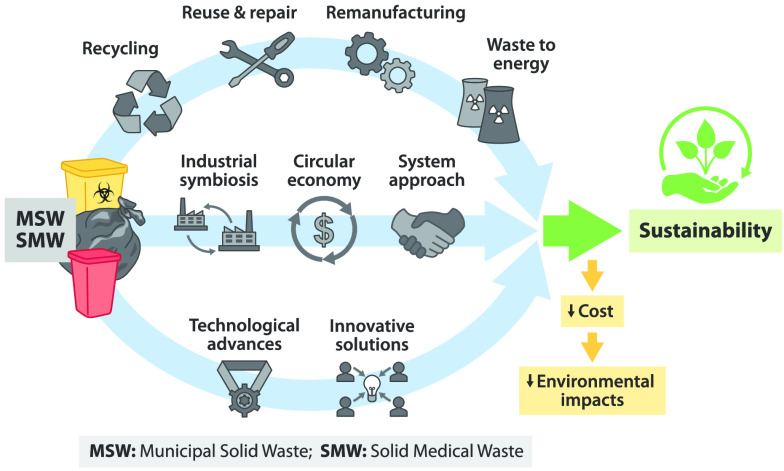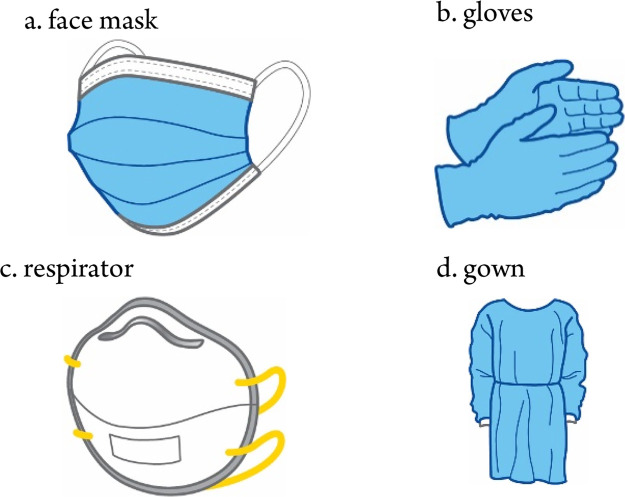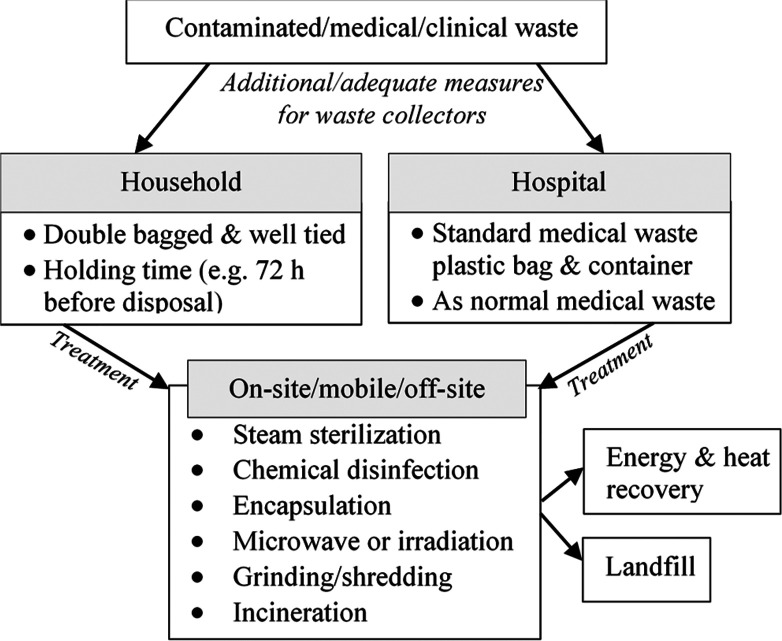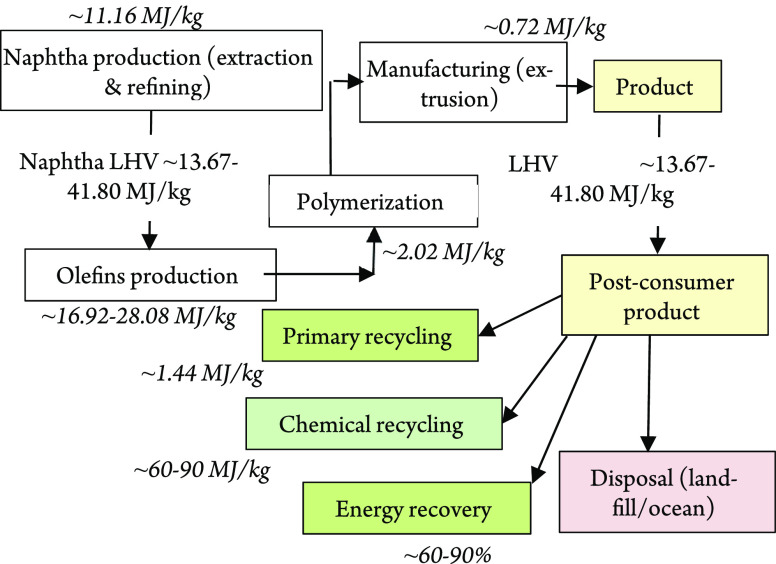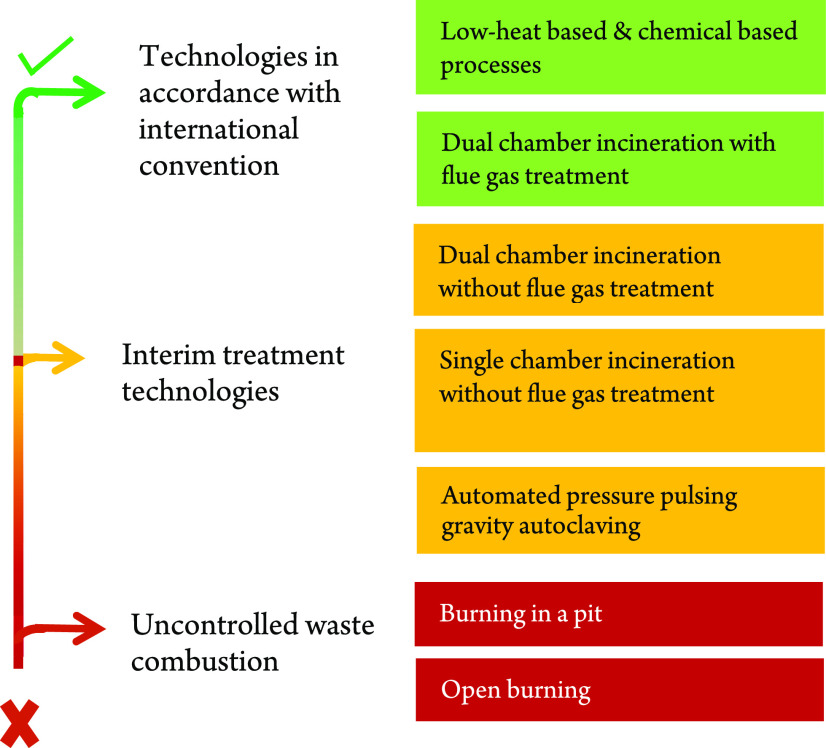Abstract
The COVID-19 pandemic disrupted the municipal essential services, including municipal solid waste (MSW) management. This study has reviewed the literature on MSW and solid medical waste (SMW) management systems, waste management initiatives specific to this pandemic, as well as their impacts now and beyond. Waste segregation and separate treatment of waste streams play important roles in reducing the environmental, health, and social impacts of waste and waste management. The global warming potential of MSW and SMW were found to be varied from −0.64 to 520 kg CO2 equiv/tonne and −52.1 to 3730 kg CO2 equiv/tonne, respectively, which widely depend on the sterilization and disposal processes. Similarly, MSW and SMW disposal costs varied from 90 to $242/tonne and 12 to $1530.0/tonne, respectively. Various changes made to waste collection and management because of the COVID-19 pandemic affected waste segregation and recycling. Since the start of the pandemic, various sectors, including the food, waste management, and healthcare sectors, relied on the increased use of single-use plastics to prevent transmission of COVID-19. An environmentally friendly alternative (biodegradable/compostable) to widely used single-use plastics is desired for easing waste management problems. Although various initiatives are underway to manage growing volumes of MSW and SMW, while controlling the spreading of infectious diseases, the movable grate incineration technology coupled with an adequate disinfection process presents a potential solution in managing the COVID-19 waste challenges. The proper disinfection method and technological choices can mitigate the risk of spreading infections and can improve the waste management system’s sustainability, especially the contaminated waste.
Introduction
Municipalities provide waste management services to their residents to meet one of their basic/essential needs– safe and timely collection of waste. These vital services are often interrupted by disease outbreaks, as seen with the novel coronavirus (COVID-19), which can result in the improper storage and disposal of waste. The buildup of wastes often contaminated with organic matter, micro-organisms, and biological fluids can lead to sanitary problems or even collapse entire municipal waste management systems1 and resultantly cause frustration and feelings of distress.2,3 Poorly managed waste can result in social, environmental, and health consequences including an increased risk of spreading infectious diseases, especially during pandemics like COVID-19.4 Proper management of municipal solid waste (MSW) and solid medical waste (SMW) is crucial to controlling the spread of infectious diseases.1,5,6 SMW is generally disinfected and then treated as general MSW by municipalities. For example, the disinfected SMW managed along with MSW is usually landfilled in Canada, but management varies by jurisdiction.7 The potential severity of disease transmission through improper handling of waste depends on both the category of waste and local vulnerability.8 In 2020, COVID-19 disrupted and challenged municipal waste management systems, which were oftentimes already operating unsustainably, without the ability to safely manage additional volumes of waste and other obstacles presented by the pandemic.9 COVID-19 virtually devastated every sector of human activities, including education, economy, food, and healthcare systems, resulting in related consequences to MSW management systems.6,10 For example, in Europe, 80% of companies in the textile and apparel sector were laying off their workers because sales were cut in half due to the pandemic.11
The outbreak of COVID-19 in March 2020 created several unforeseen pressures on municipal waste management. In most jurisdictions, services were permitted to continue despite various lockdown and curfew measures put in place to thwart transmission of the virus. Waste management personnel who continued to work throughout the pandemic were more likely to be exposed to the virus through close contact with other employees or contact with contaminated materials.12 At the same time, municipal services saw an increased rate of absenteeism, straining their workforce and affecting their operability.13−17 Meanwhile, as people changed their daily lifestyle to work from home, typical waste trends and volumes also changed, requiring adjustments to program delivery.1 Municipal waste programs also had to contend with an influx of used personal protective equipment (PPE) (Figure 1), often made of single-use plastics, including masks and gloves, as well as single-use and recyclable plastics used to prevent contamination of foodstuffs and other consumer goods. Globally, every month, 129–210 billion disposable masks and 65 billion disposable gloves are used.18−20 Further, waste has skyrocketed in the healthcare sector during the COVID-19 pandemic.5,21,22 Improper management of medical waste has adverse impacts on society.21 In the recognition of the risks and challenges associated with waste management during a global pandemic, sources have advised jurisdictions to ensure adequate precaution for waste collectors, making adjustments to recycling programs23,24 and in planning for the safe treatment of increased quantities of medical waste in order to ensure public safety and to abate the dissemination of infectious diseases.2,6,25
Figure 1.
Commonly used PPE.
Although numerous initiatives are underway to phase-out single-use plastics to mitigate environmental pollution from waste plastics, demand for some single-use plastic products has surged due to the COVID-19 outbreak. The increased use of PPE has created an enormous demand for single-use plastic products, including face masks, face shields, gloves, head mobs, gowns, and shoe covers, all of which require safe disposal, thus creating problems for downstream waste management.26 In addition, various levels of government have mandated the use of face masks in public places and businesses to reduce the spread of COVID-19.27−30 Polypropylene melt-blown nonwoven fabric is the primary filter material used in a medical mask. However, masks are also produced from polystyrene, polyethylene, polycarbonate, and polyester.31 The increasing production and consumption of single-use plastic products during the COVID-19 pandemic could have long-lasting adverse impacts on the environment and global goals to reduce reliance on single-use materials and circular economy initiative.
A 70% increase in waste generation is expected by 2050 (3.4 billion tonnes) from the 2016 level (2.01 billion tonnes) in the world due to the population and urban growth.35 The waste generation rate (36.1 tonnes per person/year) is reported to be the highest in Canada and produced 1.33 billion tonnes of waste in 2017.36 Residual pathogens in medical waste make waste management problematic as the waste must be decontaminated before being disposed of.37 Various efforts and management strategies are being implemented to manage the surging waste during this pandemic; however, technological advances in MSW and SMW management, their environmental, economical, and societal impacts are yet to be synthesized. This study compiles waste management initiatives that are being implemented during the COVID-19 pandemic to discuss their advancement and their environmental, economical, and societal impacts.
Methods
Various academic search engines (ScienceDirect, Google Scholar, SpringerLink, Mendeley, Scopus platforms, Worldwide science, etc.), as well as online information (google, news articles, reports, Web sites) were used to assemble literature related to MSW and SMW management in prepandemic and pandemic periods. MSW, SMW, COVID-19 waste, healthcare waste, waste management technologies, contaminated waste management, life cycle assessment, environmental impacts, and economic and societal impacts were used as keywords. Based on the initial screening (e.g., titles and a brief check of abstracts), 141 articles were collected and grouped according to their categories (introductory, environmental, economic, societal). It is worth mentioning that the literature was searched in English only. The collected literature was then synthesized (126 articles) in the corresponding sections of in this article, while the irrelevant articles were removed from the corresponding folders.
COVID-19 Outbreak and MSW Management
The COVID-19 pandemic has led to unprecedented challenges in handling MSW, including the influx of SMW and single-use plastic PPE in waste streams.38−40 Contact with contaminated surfaces is one common mode of infectious disease transmission and plays a crucial role in spreading infectious diseases.41 Consequently, usual waste management practices have been augmented due to the pandemic to reduce interaction between site staff and the public, thus reducing the risk of spreading infectious diseases.39,42,43 However, a recent study has argued that fomite plays a small role in COVID-19 transmission, and there has been an overemphasis on cleaning surfaces and disinfecting packages.44
Municipal waste management facilities are typically designed to handle a predictable and steady waste flow rate, with some seasonal variations on waste volume. During the COVID-19 pandemic, the volume of medical waste dramatically increased, while increases and decreases in MSW volume have been reported in different regions.11,40,45 For example, during the COVID-19 pandemic, New York has generated 3.3 and 13.3% more MSW and organic waste, respectively.43 On the other hand, Catalonia and Barcelona have also produced 16.7 and 25.0% less municipal waste, respectively.11 The generation of MSW also declined in some provinces of China.46 In Wuhan, the generation of medical waste increased from 40 to 240 tonne/day due to this pandemic, surpassing the city’s maximum incineration capacity (49 tonne/day).45,47 Consequently, the city deployed 46 mobile waste management plants to handle SMW.40 In Romania, increasing healthcare waste generation has been reported, where medical and quarantine waste contributes 10.9 and 17.2% to total waste flow, respectively.5 An increase in the generation rate of agricultural waste has also been reported in some regions, due to disruptions in supply chains and processing facility shutdowns causing spoilage of perishable foods.42,48
The residential waste generation rate noticeably increased in Ontario, Canada (15% for garbage and 20% for green bin waste, while waste in blue bins remained static) but declined in commercial sectors.49 Similarly, a decline in commercial waste in other municipalities/countries has also been reported.50 For example, commercial waste generation decreased to 57% of normal levels in Tokyo due to business closures and lockdown protocols; however, a 110% increase in household waste was reported.50
The increase in MSW results from several different causes and effects during the COVID-19 pandemic. The enforcement of lockdown protocols forbidding in-person dining has led to an increased use of single-use plastics for packaging of takeout food and food delivered to residences.26 The annual growth of PPE use and resulting disposal is estimated to be 20% (relative to pandemic period, i.e., 2020) even in the postpandemic period and may continue up to 2025.51,52 It is estimated that PPE production needs to be increased by 40% globally to meet the rising demand.53 Consequently, healthcare waste is expected to continue to rise until the pandemic is over or even in the postpandemic period, as the global population adjusts to a new normal.
Commonly used disinfection and contaminated waste management technologies are autoclaving, microwave treatment, plasma treatment, and incineration (Table 1). The choice of technology used to disinfect contaminated waste depends on technical, environmental, and economic factors, as well as social acceptance.54 Since the outbreak of COVID-19, the sudden surge of waste flows swamped the current waste management facilities.25,26 In the USA, the estimated COVID-19 waste generation was 530 million tonnes per year.51 In Canada, COVID-19-related plastic waste generation from PPE is expected to be 63,000 tonnes per year.55 SMW generation rate varied from 350% in Spain11 to 600% in Wuhan, China, depending on the severity of the pandemic.26,45Table 2 depicts the waste generation rates before and during the COVID-19 epidemic in various municipalities/regions. The healthcare waste generation was found to be the highest in Wuhan (600%) and the lowest in Ha Noi (492%) among the reported cities. It appears that the change in healthcare waste generation during the pandemic depends on the severity of COVID-19 in the region, number of hospitalizations, and the population density.
Table 1. Waste Disinfection/Management Technologies Being Used to Disinfect SMW during the COVID-19 Pandemic.
| treatment | ref |
|---|---|
| high-pressure steam sterilization (121 °C, 110 min) | (25) |
| high-temperature pyrolysis (540–830 °C) | (56) |
| high-temperature incineration (800–1200 °C) | (56,57) |
| incineration (>1100 °C) | (51) |
| double-chamber incineration (primary chamber 750–980 °C temperature, while the secondary chamber is designed to operate at a temperature of at least 1100 °C | (58) |
| chemical disinfection: | |
| sodium hypochlorite (NaOCl), chlorine dioxide (ClO2), ultraviolet irradiation, ozone are used for liquid waste | (57) |
| H2O2 (>0.5%); ethanol (>75%), isopropyl alcohol (>70%), formaldehyde (>0.7%), povidone iodine (>0.23%), sodium hypochlorite (>0.21%), irradiation for 60 min | (59) |
| microwave technology (177–540 °C) | (51) |
| deep burial (1–2 m, topsoil cover 1 and 2 m above the groundwater level) | (50) |
Table 2. Estimated Healthcare Waste Generation Rate before and during COVID-19 in Selected Municipalities/Province (Healthcare Waste Includes Both SMW and Liquid Waste Streams).
Various strategies are being implemented to manage the surge in COVID-19-related healthcare as well as MSW. In the European Union (EU), contaminated waste (face mask, gloves, tissues) is required to be double-bagged.11 China has directed hospitals to use double-layered medical waste collection bags, which must be labeled as COVID-19 waste, and the surface of the bags has to be disinfected with alcohol.25 China has also recommended handling of COVID-19 waste by personnel with specialized training to handle contaminated waste.25 In Germany, takeout food containers were treated as hazardous waste during COVID-19, which were usually considered as recyclable waste11
The World Health Organization (WHO) recommends onsite segregation and collection of noninfectious waste of healthcare systems as MSW, in strong black plastic bags during COVID-19,61 which contributes 80–90% to total waste.8,38,57 Households with infected members are directed to limit the use of separate waste streams for organic material and recyclable goods, which has also stimulated the use of single-use plastic bags as well as generating a mixed-waste stream and creating additional logistical problems.11 For safe handling of contaminated waste during the COVID-19 pandemic, a generalized approach has been proposed (Figure 2).26
Figure 2.
Contaminated waste handling approaches during COVID-19. Reproduced from ref (26) with permission. Copyright 2020 Elsevier.
The surge of waste has forced different countries to modify their waste management systems. For example, Spain allowed co-incineration in cement plants if necessary, and Norway permitted changes in landfilling.11 However, China preferred onsite and mobile treatment (high-temperature incineration) of contaminated waste due to its flexibilities.25,26 Onsite incineration (23 incinerators are in operation in hospitals) of SMW has also been reported in Romania.5 On the other hand, the UK has increased their temporary storage capacity of MSW to manage increasing waste during COVID-19.62 The recycling of sharp medical waste like needles/syringes in the steel industry (co-incinerated with coke) has also been reported in Australia.63
Usually, most MSW is sent to landfills in both developed and developing countries in prepandemic periods, except for a few developed countries (Japan, Denmark, Sweden).38 In developed countries, incineration is reported to be the primary waste management process for MSW, followed by landfilling and resource recovery, while in developing countries, the primary method is landfilling.38 Japan sends only 4% of her MSW to landfill sites, whereas 74 and 17% is incinerated and recycled, respectively.64 A lower rate of landfilling has also been reported in some European countries (such as Denmark, Finland, Norway, and Sweden), where more than 50% of MSW is incinerated for energy recovery.65 In the UK, only 20% of the biodegradable portion of MSW was sent to landfilling in 2018.66 However, more than 50% of MSW is sent to landfill in the USA and 95% in Canada.67−69 In many developing countries (Bangladesh, Brazil, India, Indonesia, China, Thailand, etc.), a major portion of MSW is sent to the landfill.38,70 For example, in India, 70% of MSW is sent to landfill.71
Changes to MSW management have been implemented in both developed and developing countries because of the COVID-19 pandemic38 to ensure adequate protection against the transmission of the virus. For example, cities/regions/countries have temporarily stopped or reduced their waste recycling programs and waste segregation due to the pandemic,11,72,73 thereby reducing the sustainability of the waste management system.74−76 The scarcity of landfill sites and concerns about greenhouse gas (GHG) emissions and leachate have also led to the search for alternate disposal technologies. Some regions lack a COVID-19 MSW management strategy. For example, strategies are lacking for managing the COVID-19-related solid waste in Nigeria.77 Although a coordinated waste collection system is reported to be effective in an area which lacks municipal waste collection service, especially in slum areas,78 the pandemic has disrupted those initiatives. Acknowledging the informal economy and primary stakeholder’s involvement is crucial to a sustainable waste management strategy.77,79 The hierarchy of zero waste can be useful for the stakeholder in outlining the waste management strategy to abate GHG emissions (Figure 3).88
Figure 3.
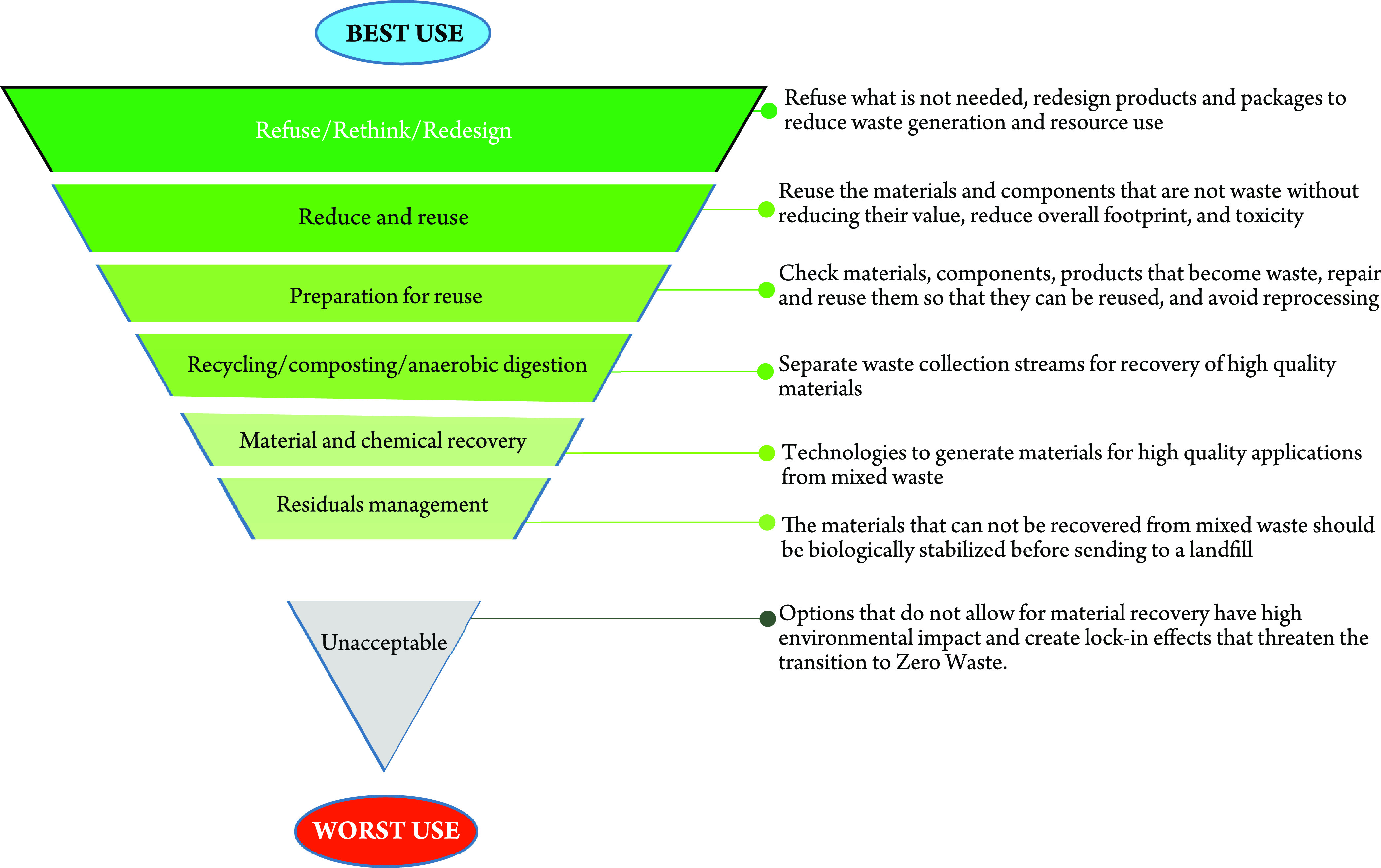
Hierarchy of waste management. Reproduced from ref (88). Copyright 2019 Zero Waste Europe.
Environmental and Economic Impacts of Solid Waste Management Systems
The increased use of single-use plastics during the pandemic has adverse effects on MSW management and creates unintended environmental concerns. For example, the energy consumption drastically increased in managing medical wastes (healthcare waste from hospitals and personal care from residence) and thus the environmental footprint.6,26 Emissions from the SMW incineration depend not only on the categories of the waste but also on the type of incinerators and operating parameters.80−82 For example, Van et al.83 used a wet scrubber (using 20% NaOH solution) and stack for gas cleaning; however, a bag filter and two stages of wet scrubber were adopted by Xie et al.80 Usually, SMW consists of various types of plastics. The quality of waste streams depends on their compositions, especially the MSW, and thus the production of flue gas/syngas.81 Among the different plastic waste management technologies, incineration is identified to be the second best, while recycling is noted to be the best in terms of environmental impact.84 A higher recycling rate improves the sustainability of waste management systems.75,76,85 However, incineration becomes a common practice for contaminated plastic waste to mitigate infectious disease from waste handling.
The GHG emissions from the incineration of various waste streams in different countries/regions are presented in Supporting Information, Table SI-1. The concentration of CO2 in the flue gas from the incineration process varied from 7.1 to 9.8%.86 The emission limit (CO, SO2) is found to be the highest in Vietnam followed by the US and China. On the other hand, HCl and NOx emission limits were highest in Japan. However, the measured emissions were greater than the specified limits. This variation might be the result of the selected technology. Widespread incineration of SMW or MSW in a densely populated area might be problematic because of the emission of pollutant gases.82 A wide variation in the composition of MSW was also observed in the review literature. The organic waste contributed 28–64%, and plastics contributed 8–20% to total MSW (Table SI-2). A wide variation in pollutant gas emissions is observed because of the difference in technology and gas cleaning methods applied in the incineration process as well as the composition of waste streams, which varies depending on the countries/regions.82,87
A wide range of environmental impacts is reported for different waste management systems (Table 3). These variations resulted from the composition of the waste stream, type of waste, management systems, energy recovery system, system boundary, sources of energy used in the waste management processes, etc.89,90 For example, in China, electricity from coal-fired power plants is used in waste management, whereas in Brazil, electricity from hydropower is used, and thus the same two waste management technologies using the same amount of electricity would have different environmental impacts because of the energy source.90 The environmental impact of MSW also depends on the method of disposal.91,92 For example, incineration and landfilling produces 0.53 tonne CO2 equiv and 10.84 tonne CO2 equiv per tonne of MSW, respectively.91 The environmental impacts of waste management were reported to be the highest for uncontrolled landfilling of MSW and the lowest for incineration of the residual portion of MSW, with the remainder going to landfills. The inclusion of incineration with composting of the wet organic portion and recycling of the recyclable portion was environmentally preferable.89 On the other hand, anaerobic digestion of organic waste was preferred compared to composting.65
Table 3. Environment Impacts of SMW and MSW Managementa.
| impacts/tonne |
|||||||||
|---|---|---|---|---|---|---|---|---|---|
| waste type | technology | database/method | GWP | OD | FFD | AP | WD | remarks | ref |
| SMW* | incineration | GaBi | 10.6 | 1.00 × 10–14 | 1.84 × 10–04 | 2.24 × 10–06 | 1.52 × 10–04 | (63) | |
| SMW | incineration | Ecoinvent | 1190.0 | - | - | - | - | 0% ER | (93) |
| SMW | incineration | Ecoinvent | 682.0 | - | - | - | - | 15% ER | (93) |
| SMW | incineration | Ecoinvent | –52.1 | - | - | - | - | 30% ER | (93) |
| SMW (mixed) | steam sterilization and landfilling | Ecoinvent | 461.0 | - | - | - | - | 0% ER | (93) |
| SMW (mixed) | steam sterilization and landfilling | Ecoinvent | 451.0 | - | - | - | - | 10% ER | (93) |
| SMW (mixed) | incineration | spreadsheet | 688.5 | - | - | - | - | ash landfilled | (105) |
| SMW | pyrolysis and sanitary landfill | ReCiPe | 1260.0 | 5.05 × 10–06 | 182.37 | 2.60 | 71.87 | sanitary landfilled | (90) |
| SMW | steam sterilization and incineration | ReCiPe | 3730.0 | 6.87 × 10–06 | 429.75 | 5.22 | 109.30 | ash landfilled | (90) |
| SMW | chemical disinfection and incineration | ReCiPe | 800.7 | 2.21 × 10–06 | 151.30 | 0.95 | 33.31 | ash landfilled | (90) |
| MSW | incineration | SimaPro (Impact 2002+) | –0.648 | –1.87 × 10–09 | - | –0.0037 | - | ash used as a building material | (106) |
| SS | incineration | SimaPro (Impact 2002+) | 0.865 | 4.33 × 10–08 | - | 0.0031 | - | wastewater collected to WWTP | (106) |
| MSW and SS | co-incineration | SimaPro (Impact 2002+) | –1.44 | 8.71 × 10–09 | - | –0.0035 | - | ash landfilled, building materials | (106) |
| MSW | incineration | GaBi (EDIP 97) | 271.0 | - | - | –0.748 | - | ash landfill | (107) |
| MSW | landfill | GaBi (EDIP 97) | 502.0 | - | - | –0.302 | - | ER | (107) |
| MSW (mixed plastic) | gasification-pyrolysis | SimaPro (ecoinvent) | 1870.0 | - | - | 2.43 × 10–05 | - | ER | (108) |
| MSW (mixed plastic) | incineration | SimaPro (ecoinvent) | 0.898 | - | - | –6.57 × 10–04 | - | ER | (108) |
| MSW (mixed paper) | gasification-pyrolysis | SimaPro (ecoinvent) | 1560.0 | - | - | 9.86 × 10–05 | - | ER | (108) |
| MSW (mixed paper) | incineration | SimaPro (ecoinvent) | 1030.0 | - | - | –5.27 × 10–05 | - | ER | (108) |
| MSW | composting and landfilling | SimaPro (ecoinvent) | 376 | - | - | 3.2 | - | no ER | (109) |
| MSW | landfilling | SimaPro (ecoinvent) | 2240.0 | 24.6 | no ER | (109) | |||
| MSW | landfilling | SimaPro (ecoinvent) | 766.9 | 2.78 × 10–06 | - | 1.2 | - | ER | (110) |
| MSW | incineration | SimaPro (ecoinvent) | –121.6 | –2.47 × 10–05 | - | –2.9 | - | ER, ash landfilled | (110) |
| MSW | composting, incineration, landfilling | SimaPro (ecoinvent) | 178.9 | 2.02 × 10–05 | - | –0.2 | - | ER | (110) |
| MSW | composting, recycling, incineration, landfilling | SimaPro (ecoinvent) | –153.1 | 1.93 × 10–05 | - | –1.0 | - | ER | (110) |
| MSW | landfilling 32.7%, incineration 41.2%, recycling 17.5%, composting 8.6% | - | 1076.0 | - | - | - | - | ash landfilled, no ER | (111) |
| MSW | landfilling 54.7%, incineration 40.7%, recycling 3.4%, composting 1.2% | - | 487.9 | - | - | - | - | no ER | (111) |
| MSW | landfilling 7.3%, incineration 57.6%, recycling 31.5%, composting 12.9% | - | 211.3 | - | - | - | - | ER | (111) |
| MSW | AD (food waste, garden waste) recycling and incineration | - | –142.3 | - | - | - | - | ER | (111) |
SMW, solid medical waste; MSW, municipal solid waste; SS, sewage sludge. *Syringe; GWP, global warming potential (kg CO2e/tonne); OD, ozone depletion (kg CFC-11); FFD, fossil fuel depletion; AP, acidification potential (kg SO2 e/tonne); WD, water depletion (m3); ER, energy recovery; WWTP, wastewater treatment plant; AD, anaerobic digestion; EDIP, environmental design of industrial products.
Several authors argued that a portion of environmental pollution and the economic burden of SMW management could be offset by heat and energy recovery from the incineration system.90,93 Among chemical disinfection, steam sterilization, and pyrolysis process, steam sterilization and chemical disinfection had the highest environmental impacts and the lowest economic burden, respectively.90 In contrast, chemical disinfection combined with pyrolysis and landfilling of SMW is a better option compared with incineration combined with landfilling or direct landfilling.94 Zhao et al.93 argued that environmental impacts could be offset if the appropriate measures are taken during the waste management process, such as energy recovery. The energy recovery also depends on the type of waste, embodied energy, energy recovery efficiency, and incineration parameters.26,63,93Figure 4 represents the embodied energy and energy recovery from various waste management stages (plastics).26 The demand and supply of recovered energy and heat have to be balanced to successfully implement the pandemic waste incineration process, while social acceptability can play a crucial role.
Figure 4.
Energy flows in different stages of a product without transportation. Reproduced from ref (26) with permission. Copyright 2020 Elsevier.
Plastics have greater embodied energy than paper or wood95−97 and thus have higher energy recovery efficiency,26 and the recovered energy offsets a portion of the environmental impacts. Other impact categories (eutrophication, carcinogens, respiratory inorganics, etc.) were also greater in the case of steam sterilization and incineration compared with chemical disinfection and incineration.90 In contrast, chemically disinfected waste landfilling has a higher environmental burden compared with steam-sterilized waste landfilling in Brazil.98 This contradictory outcome resulted mainly because of the source of electricity that was used in the waste treatment process (usually, in China, electricity generates from coal, but hydropower is used to generate electricity in Brazil).90 In addition, the composition of MSW may also have played an important role in the resulting environmental impacts.
The waste management cost is also reported to be dependent on the adopted technology or type of waste and the location of treatment/disposal (Table 4). For example, airflow controlled (AFC) incineration was reported to be suitable for a small-scale operation to reduce MSW management costs.83 The higher recycling rate reduces waste management cost.85 In China, SMW incineration cost is $281.7–$422.6 per tonne, whereas the MSW incineration cost is $14.1 per tonne.45 Consequently, the surge of medical waste has put extra pressure on municipalities’ waste management budget around the world. However, in Canada, the MSW disposal cost is $90–$242 per tonne, where most of her MSW is sent to the USA for landfilling, and the tipping fees are the main contributor to the total disposal cost.99 The waste management cost depends on the waste stream and waste management systems and also on the energy recovery and disinfection method used.
Table 4. Waste Management Systems and Waste Management Cost.
| waste | management process | cost, $/tonne waste | remarks | source |
|---|---|---|---|---|
| SMW | pyrolysis | 293.4 | sanitary landfill after pyrolysis | (90) |
| SMW | incineration | 263.3 | chemically disinfected waste incinerated; ash landfilled | (90) |
| SMW | incineration | 454.7 | steam-sterilized waste incinerated, ash landfilled | (90) |
| SMW | landfilling | 1100.0 | chemically disinfected waste landfilled | (98) |
| SMW | landfilling | 1530.0 | steam-sterilized waste incinerated | (98) |
| landfilling | 12.0 | microwaved waste landfilled | (98) | |
| MSW | incineration | –19.9 | energy recovery, ash used as a building material | (106) |
| SS | incineration | 50.0 | energy recovery, wastewater send to WWTP | (106) |
| MSW and SS | co-incineration | –31.6 | energy recovery, ash send to landfill/building materials | (106) |
MSW: municipal solid waste; SMW: solid medical waste; SS.: sewage sludge.
Ongoing Efforts in MSW Management
Numerous efforts are underway in the development process of PPE to protect frontline workers against COVID-19 and reduce the waste management problems associated with the COVID-19-related waste.100 China has formed a multisectoral team to safely manage surging healthcare waste during COVID-19.25 Antiviral face mask filters are also being developed to enhance the reusability of conventional masks (such as surgical and N95 masks), which are not normally antiviral.101 For example, salt101,102 and copper ions103 are being used in the antiviral face mask development process. For quick decomposition of COVID-19 waste, the use of plasma energy has also been recommended.57 Organic Rankine cycle combined with the MSW incinerator has also been used to process cleaned SMW.104
The goal programming (a program that is commonly used to optimize a process) was used to determine the most suitable incineration location of SMW in Serbia to minimize environmental pollution and risks.112,113 The optimization models are also noted to be useful for the hospital waste management decision-making process.114 The application of root cause analysis, risk matrix, failure mode effects analysis, event tree analysis, hazards and operability study, etc. has also been reported in optimizing SMW management systems.113 Compositional Bayesian regression has also been applied to predict waste generation and its environmental impacts.75 The system approach115 and the neural network modeling91,116 have also been used in MSW management processes.
Countries have twisted/turned away from landfilling to incineration due to environmental concerns and the scarcity of landfilling area117 and to mitigating global waste management problems,82 which should be widely adopted with technological advances and greater investment in the waste management sector. Incineration reduces 80–95% of the volume of solid waste;118,119 thus, this would be the better option during the pandemic in controlling infectious diseases and mitigating environmental pollution; however, the risk of spreading infectious diseases during transportation remains.120 The mobile incineration process with heat and energy recovery would be a potential solution to reduce risks during transportation. However, the composition of MSW may have played an essential role in selecting waste management technologies. In developing countries, organic waste is the main contributor to the MSW; however, paper and plastics have dominated in the developed countries.75,82,109
The double chamber incinerator reduces emissions by increasing gas residence time and encouraging turbulence in the chamber.58 The incinerators equipped with the fluidized bed or moveable grate technology are commonly used to manage MSW, but the fluidized bed incinerator is losing ground because of the requirement of energy-intensive pretreatment (such as shredding) and higher fly ash generation.81 On the other hand, movable grate incinerators can be used to manage the waste as received, which might be useful in processing COVID-19 waste and mitigating particulate emission. In Australia, Brazil, and in Asia (except China), only the movable grate inclinators are used to manage MSW. However, in other regions or countries, the use of fluidized bed and rotary kiln technology were 20–29 and 3–8%, respectively (Figure 5).82
Figure 5.
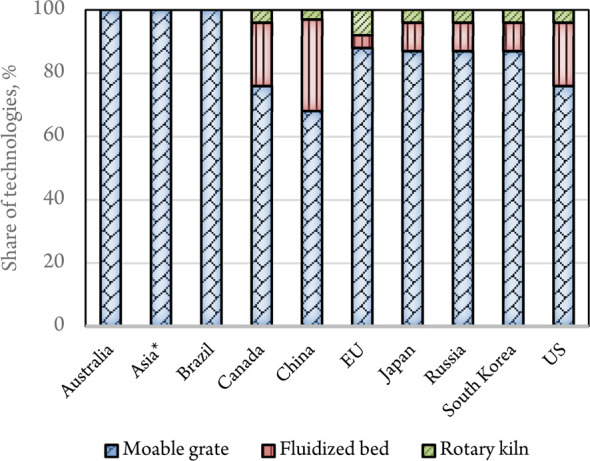
MSW incineration technologies used in different countries/regions (*except China). Reproduced from ref (82) with permission, Copyright 2018 Elsevier.
The waste management associations in the EU were urged to make the circular economy action plan and European green deal as an integral part for the COVID-19 recovery plan as well as call for discussion for proper management of residual waste.121 The WHO recommends three categories of contaminated waste management technologies based on their preference. For example, open burning or burning in pit is identified to be the least preferable, whereas autoclaving, single and double chamber incinerators are intermittent, and dual chamber incineration as well as the low heat-based chemical processes are the most preferable technologies (Figure 6).122 Waste segregation and separate treatment of waste streams depending on their characteristics is found to be the key to reducing the environmental impacts of the waste management system. For example, anaerobic digestion of food waste, recycling of the recyclable portion of MSW instead of incineration, as well as waste prevention are noted to be environmentally beneficial.111
Figure 6.
Recommended technology ladder for contaminated healthcare waste. Reproduced from ref (122). Copyright World Health Organization, License CC BY-NC-SA 3.0 IGO (https://creativecommons.org/licenses/by-nc-sa/3.0/igo/).
Discussion
The pandemic outbreaks have a significant effect on the generation of MSW and SMW as well as their management. Although waste collection has a vital role in recycling and recovery, disrupted waste collection and management have created numerous problems in waste management systems such as recycling activities, thus in the circular economy.123 The governmental directives on COVID-19 failed to mitigate the hassles of waste collectors/workers.39,124 Some of the collectors face health problems probably from infectious diseases because of the presence of disposed face masks, hand gloves, and other contaminated medical waste in the waste stream collected.124 Consequently, waste workers have advocated for more equitable and inclusive urban policies, especially during COVID-19.125
Inadequate waste management during the pandemic and postpandemic period aggravates waste management and intensifies infectious disease transmission. Technological advances (design, decentralization, automation, etc.) and investment by both public and private institutions can enhance uninterrupted waste collection and management. Although the mobile incineration process might be a suitable option in the timely management of infectious waste, it may raise air pollution in a populated area, as the healthcare facilities are usually located in urban and populated areas that need to be carefully addressed.
Solid waste management data play a vital role in waste management planning and policy development, especially with the increasing population growth and urbanization.4 A database on the waste generation and waste management in prepandemic and pandemic periods will be useful in predicting waste generation and preparing for an effective waste management for any future pandemic outbreak. In addition, any attempt in easing regulations and rules on contaminated waste management has to be done with careful consideration.
It has also been estimated that various measures imposed to control the spread of COVID-19 emerged to be beneficial to the environment but has a reverse impact on the economy. For example, in New York, air pollution dropped to 50% compared to last year; however, China observed a 25% decrease in emissions.22 Due to the mixed impact of the COVID-19 pandemic and prediction of long-term economic, behavioral, and societal changes,126 system dynamics and causal loop diagram modeling could help for better understanding of the changes in the waste generation.42,115
Although various waste management systems have been implemented due to the pandemic, their environmental, economic, and societal impacts/viability need to be evaluated. The initiative to improve the sustainability of waste management systems by increasing the recycling rate may be disturbed because of the pandemic as countries/regions are forced to adjust their waste management strategies to control the spread of infection. Consequently, adequate/appropriate disinfection coupled with incineration would be a recommended waste management system during this pandemic to improve the sustainability of the waste management system.
Summary and Recommendation
Segregation of contaminated and noncontaminated waste at the source and subsequent application of recycling and appropriate waste management strategies are recommended for mitigating the environmental impact of MSW and SMW during a pandemic scenario. This strategy needs to be continued even at the postpandemic period to reduce the environmental impacts and health risks. Numerous efforts are underway to minimize the waste management problems associated with an increased volume of MSW and SMW experienced by many jurisdictions during the COVID-19 pandemic. Although various programs are being implemented to improve the waste management systems during the pandemic, innovative methods are required to safely handle the infectious waste while minimizing environmental impact, ensuring sustainable waste management and overall contributing to a circular economy. Technological advances are a must for minimizing waste management problems, and the inclusion of stakeholders from every sector of the waste management systems would be key in developing sustainable waste management policies. This can ensure that waste management systems are resilient in the event of future crises.
In addition, careful consideration needs to be placed in technological choice depending on the waste composition, locations, and social acceptance. To improve the sustainability of waste management systems, the following initiatives can play an important role:
Design and development of alternatives to conventional single-use plastics including PPE.
Initiate an integrated waste management by engaging the stakeholders associated with MSW and SMW.
Finally, a broader sustainability check is imperative to determine the systems economic and environmental viability that can mitigate the risk on investment thus in improving the waste management system’s sustainability.
Acknowledgments
This study was financially supported by the Ontario Ministry of Agriculture, Food and Rural Affairs (OMAFRA)—University of Guelph, the Bioeconomy Industrial Uses Research Program Theme (Project Nos. 030251, 030486 and 030578); the Ontario Ministry of Economic Development, Job Creation and Trade ORF-RE09-078 (Project Nos. 053970 and 054345); the Natural Sciences and Engineering Research Council of Canada (NSERC), Canada Research Chair (CRC) program Project No. 460788; and the Agriculture and Agri-Food Canada (AAFC), Maple Leaf Foods, Canada and the Bank of Montreal (BMO), Canada through Bioindustrial Innovation Canada (BIC) Bioproducts AgSci Cluster Program (Project Nos. 054015, 054449, and 800148).
Biographies
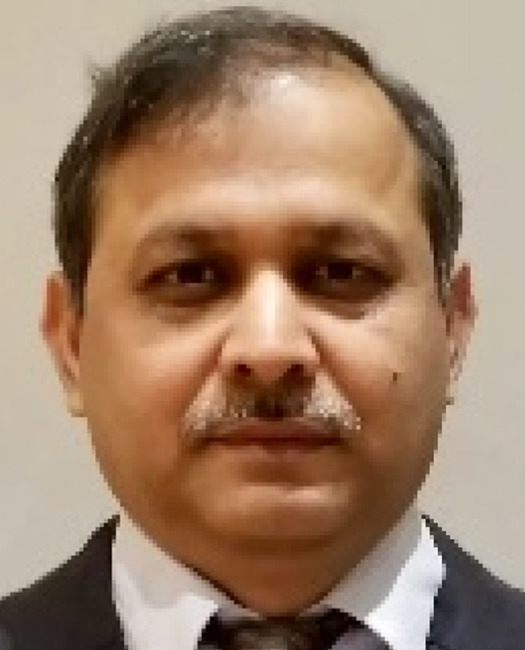
Dr. Poritosh Roy is an Agricultural Engineer (P. Eng). His areas of research interest are value-added product development from biomass (thermochemical and biochemical conversion, co-processing), bio-based economy, bioprocessing and bioreactor design, food processing, industrial symbiosis, life cycle assessment and life cycle costing of agri-food industries. He has authored/co-authored 57 peer-reviewed research articles and 5 book chapters. He served as a Guest Editor for special issues of Sustainability (MDPI) and AIMS Energy (AIMS Press). He is an Editorial Board Member of AIMS Energy and the Journal of Food Science and Nutrition Therapy. Presently, Dr. Roy is working as a researcher at Bioproducts Discovery and Development Centre (BDDC) and Special Graduate Faculty at the School of Engineering, University of Guelph, Ontario, Canada.

Dr. Amar K. Mohanty is a Full Professor and OAC Distinguished Research Chair in Sustainable Biomaterials and is the Director of the Bioproducts Discovery & Development Centre at the University of Guelph. He is a former Michigan State University professor and is an international leader in the field of bioplastics, biocomposites, and advanced biorefinery. His research focuses in engineering value-added uses of biomass wastes and industrial co-products from agro-food and biofuel industries. Circular economy, environmental sustainability, waste plastic valorization, biodegradable plastics as single-use plastic alternatives, biocarbon-based composites, and 3D printing of sustainable materials are other areas of his expertize. Prof. Mohanty is the Editor-in-Chief of Sustainable Composites, Composites Part C – Open Access (Elsevier).He has more than 800 publications to his credit, including 422 peer-reviewed journal papers, 6 edited books, over 400 conference presentations, 25 book chapters, and 67 Patents awarded/applied (his Google Scholar citations exceed 40, 000). Prof. Mohanty is a Fellow of the Royal Society of Canada, the American Institute of Chemical Engineers, the Royal Society of Chemistry (UK) and the Society of Plastic Engineers. Prof. Mohanty received many awards, including the JL White Innovation Award from the International Polymer Processing Society, the Synergy Award for Innovation from the Natural Sciences and Engineering Research Council of Canada (NSERC), the Andrew Chase Forest Products Division Award from the American Institute of Chemical Engineers, and the Lifetime Achievement Award from the BioEnvironmental Polymer Society (BEPS).

Alexis Wagner is a Manager in the Consumer Products Directorate at Innovation, Science and Economic Development Canada (ISED)—a Department in the Government of Canada. In her role, she leads research, analysis, and policy advice to support a globally competitive food and beverage processing sector. Prior to joining ISED in 2019, Alexis enjoyed an accomplished career in the brewing industry. She began her career with Labatt Breweries and then took on head brewer and assistant brewmaster roles with Mill Street Brewery—Canada’s largest craft brewery. Alexis holds an MPhil in Environmental Policy from the University of Cambridge, where she researched farm-level adoption of Beneficial Management Practices as a Chevening Scholar. She received her undergraduate degree in Biological and Food Engineering from the University of Guelph in Canada. She published research on bioplastic nanofibers, while at the University’s Bioproducts Discovery and Development Centre. Alexis currently serves on the board of several organizations that address different aspects of the food system.

Dr. Shayan Sharif earned his Doctor of Veterinary Medicine degree in 1991 (with distinction) from the Faculty of Veterinary Medicine, University of Tehran, Iran, and a PhD from the University of Guelph in 1999. Dr. Sharif received a post-doctoral fellowship to begin his post-doctoral research in January 1999 in Immunology at The John Robrats Research Institute, London, Ontario. He was recruited by the University of Guelph in 2001 and was promoted to Professor in 2011. Dr. Sharif’s research is focused on elucidating the ways in which microbes interact with the chicken immune system. The ultimate goal is to develop better strategies to maintain and promote poultry health. Dr. Sharif has published over 200 peer-reviewed research articles and has been successful in obtaining external grants. So far, he has received over $16,000,000 research grants from the poultry industry as well as from provincial and federal granting agencies, as the principal investigator or co-PI. Dr. Sharif is the leader of the Poultry Health Research Network, an interdisciplinary network of poultry researchers and poultry health specialists. He has received the Pfizer Award for Research Excellence (2009) to recognize his research excellence. For the period between 2017 and 2020, he was a University Research Leadership Chair. Dr. Sharif is currently the Co-Editor-in-Chief for Veterinary Immunology and Immunopathology. He is also the Associate Dean, Research and Graduate Studies for the Ontario Veterinary College.

Dr. Hamdy Khalil is the Senior Global Director for Advanced Technologies Research and Product Development and Innovation for the Woodbridge Foam Corporation at The Woodbridge Group. Dr. Khalil pioneered the introduction and commercialization of renewable materials into the polyurethane chemistry used in interior automotive parts manufacturing. Prior to his present position at Woodbridge Foam Corporation, Dr. Khalil held positions as a senior technical manager and director BFGoodrich looked elastomers, coatings and adhesives research and development with extensive customers interface. Dr. Khalil is one of the pioneers in the development of Phase Transfer Catalysis (PTC). He holds several patents in the areas of polyurethane structural sealants, latex, styrenics, and bio polyols. He also served as an adjunct professor at the University of Guelph, a member of the Board of Directors at the Ontario Bio Auto Council and the Center for Research in the Bioeconomy, and the NRC steering Committee for Bio-products Development and the Scientific Advisory Committee at ArboraNano.

Dr. Manjusri Misra is a professor and Tier 1 Canada Research Chair (CRC) in Sustainable Biocomposites in the School of Engineering and holds a joint appointment in the Department of Plant Agriculture at the University of Guelph. As well, she is the Research Program Director of the Bioeconomy Panel for the Ontario Agri-Food Innovation Alliance, a program between the Ontario Ministry of Agriculture and Rural Affairs (OMAFRA) and the University of Guelph. Dr. Misra completed her Bachelors, Master’s, and Ph.D. at Utkal University in India, focusing in chemistry with a specialization in polymers and natural fibres. Dr. Misra’s current research focuses primarily on novel bio-based composites and nanocomposites from agricultural, forestry, and recycled resources for the sustainable bioeconomy moving toward circular economy. She has authored more than 700 publications, including 410 peer-reviewed journal papers, 21 book chapters, and 53 patents. She was the editor or co-editor of 4 books in the area of biocomposites and nano-composites. She is a Fellow of the Royal Society of Chemistry (UK), the American Institute of Chemical Engineers (AIChE), and the Society of Plastic Engineers (SPE). Prof. Misra has received many awards, including the Synergy Award for Innovation from the Natural Sciences and Engineering Research Council of Canada (NSERC), the Andrew Chase Forest Products Division Award from the American Institute of Chemical Engineers, and the Lifetime Achievement Award from the BioEnvironmental Polymer Society (BEPS). In 2020, she was selected as one of Canada’s Most Powerful Women: Top 100 Award Winner in the Manulife Science and Technology Award category from the Women Executive Network.
Supporting Information Available
The Supporting Information is available free of charge at https://pubs.acs.org/doi/10.1021/acsenvironau.1c00005.
Information on the emission limits and composition of waste streams (MSW) in different regions/countries (PDF)
The authors declare no competing financial interest.
Supplementary Material
References
- You S.; Sonne C.; Ok Y. S. COVID-19’s unsustainable waste management. Science (Washington, DC, U. S.) 2020, 368 (6498), 1438.1. 10.1126/science.abc7778. [DOI] [PubMed] [Google Scholar]
- ISWA . Waste management during the COVID-19 pandemic; International Solid Waste Association, 2020. [cited 2020 Aug 17]; https://www.iswa.org/fileadmin/galleries/0001_COVID/ISWA_Waste_Management_During_COVID-19.pdf. [DOI] [PubMed] [Google Scholar]
- Nzeadibe T. C.; Ejike-Alieji A. U. P. Solid waste management during Covid-19 pandemic: policy gaps and prospects for inclusive waste governance in Nigeria. Local Environ. 2020, 25 (7), 527–35. 10.1080/13549839.2020.1782357. [DOI] [Google Scholar]
- Kaza S, Yao L, Bhada-Tata P, Van Woerden F.. What a waste 2.0: a global snapshot of solid waste management to 2050; The World Bank, 2018. [Google Scholar]
- Mihai F.-C. Assessment of COVID-19 Waste Flows During the Emergency State in Romania and Related Public Health and Environmental Concerns. Int. J. Environ. Res. Public Health 2020, 17 (15), 5439. 10.3390/ijerph17155439. [DOI] [PMC free article] [PubMed] [Google Scholar]
- UNEP . Waste management an essential public service in the fight to beat COVID-19; United Nations Environment Programme, 2020. [cited 2020 Aug 25]; https://www.unenvironment.org/news-and-stories/press-release/waste-management-essential-public-service-fight-beat-covid-19. [Google Scholar]
- Walkinshaw E.Medical waste-management practices vary across Canada; Can Med Assoc, 2011. [DOI] [PMC free article] [PubMed] [Google Scholar]
- Alverson K. How COVID-19 Pandemic is Changing Waste Management. Heal J. 2020, 20 (4), 352–354. [Google Scholar]
- Holmes A.COVID-19 is laying waste to many US recycling programs; The Conversation, 2020. [cited 2020 Aug 26]; https://theconversation.com/covid-19-is-laying-waste-to-many-us-recycling-programs-139733. [Google Scholar]
- Weible C. M.; Nohrstedt D.; Cairney P.; Carter D. P.; Crow D. A.; Durnova A. P.; Heikkila T.; Ingold K.; McConnell A.; Stone D.; et al. COVID-19 and the policy sciences: initial reactions and perspectives. Policy Sci. 2020, 53, 225–241. 10.1007/s11077-020-09381-4. [DOI] [PMC free article] [PubMed] [Google Scholar]
- Association-of-Cities-Regions . Municipal waste management and COVID-19; Association of Cities and Regions for sustainable Resource management, 2020. [cited 2020 Aug 21]; https://www.acrplus.org/en/municipal-waste-management-covid-19. [Google Scholar]
- Samson M.South Africa’s response to COVID-19 worsens the plight of waste reclaimers, 2020. [cited 2020 Aug 18]; https://theconversation.com/south-africas-response-to-covid-19-worsens-the-plight-of-waste-reclaimers-135072.
- ILO . Managing work-related psychosocial risks during the COVID-19 pandemic; International Labour Organization, 2020. [cited 2021 May 17]; https://www.ilo.org/wcmsp5/groups/public/---ed_protect/---protrav/---safework/documents/instructionalmaterial/wcms_748638.pdf. [Google Scholar]
- MLTSD . COVID-19 (coronavirus) and your employment standards protections. Ministry of Labour, Training and Skills Development. 2020. [cited 2020 Dec 21]. Available from: https://www.ontario.ca/page/covid-19-coronavirus-and-your-employment-standards-protections. [Google Scholar]
- Groenewold M. R.; Burrer S. L.; Ahmed F.; Uzicanin A.; Free H.; Luckhaupt S. E. Increases in health-related workplace absenteeism among workers in essential critical infrastructure occupations during the covid-19 pandemic—United States, March–April 2020. Morb Mortal Wkly Rep. 2020, 69 (27), 853. 10.15585/mmwr.mm6927a1. [DOI] [PMC free article] [PubMed] [Google Scholar]
- Gaffney A. W.; Himmelstein D. U.; Woolhandler S. Illness-Related Work Absence in Mid-April Was Highest on Record. JAMA Intern Med. 2020, 180 (12), 1699–1701. 10.1001/jamainternmed.2020.2926. [DOI] [PMC free article] [PubMed] [Google Scholar]
- EurekAlert . Work absences in April highest on record, suggesting under-count of COVID cases: New study, 2020. [cited 2020 May 17]; https://www.eurekalert.org/pub_releases/2020-07/pfan-wai072720.php.
- Willis L.Are We Burying Ourselves In PPE Waste?: The impact of COVID-19 on our waste stream could last decades, 2020. [cited 2020 Oct 1]; https://emagazine.com/are-we-burying-ourselves-in-ppe-waste/.
- Prata J. C.; Silva A. L. P.; Walker T. R.; Duarte A. C.; Rocha-Santos T. COVID-19 pandemic repercussions on the use and management of plastics. Environ. Sci. Technol. 2020, 54 (13), 7760–5. 10.1021/acs.est.0c02178. [DOI] [PubMed] [Google Scholar]
- Hantoko D.; Li X.; Pariatamby A.; Yoshikawa K.; Horttanainen M.; Yan M. Challenges and practices on waste management and disposal during COVID-19 pandemic. J. Environ. Manage. 2021, 286, 112140. 10.1016/j.jenvman.2021.112140. [DOI] [PMC free article] [PubMed] [Google Scholar]
- Ibeh I. N.; Enitan S. S.; Akele R. Y.; Isitua C. C.; Omorodion F. Global Impacts and Nigeria Responsiveness to the COVID-19 Pandemic. Int. J. Healthc Med. Sci. 2020, 6 (4), 27–45. 10.32861/ijhms.64.27.45. [DOI] [Google Scholar]
- Saadat S.; Rawtani D.; Hussain C. M. Environmental perspective of COVID-19. Sci. Total Environ. 2020, 728, 138870. 10.1016/j.scitotenv.2020.138870. [DOI] [PMC free article] [PubMed] [Google Scholar]
- CDC . What Waste Collectors and Recyclers Need to Know about COVID-19; Centers for Diesease Control and Prevention, 2020. [cited 2021 Feb 24]; https://www.cdc.gov/coronavirus/2019-ncov/community/organizations/waste-collection-recycling-workers.html. [Google Scholar]
- USDL . Solid Waste and Wastewater Management Workers and Employers; United States Department of Labor, 2020. [cited 2021 Feb 24]; https://www.osha.gov/coronavirus/control-prevention/solid-waste-wastewater-mgmt. [Google Scholar]
- Peng J.; Wu X.; Wang R.; Li C.; Zhang Q.; Wei D. Medical Waste Management Practice during the 2019–2020 Novel Coronavirus Pandemic: Experience in a General Hospital. Am. J. Infect. Control 2020, 48, 918–921. 10.1016/j.ajic.2020.05.035. [DOI] [PMC free article] [PubMed] [Google Scholar]
- Klemes J. J.; Fan Y. V.; Tan R. R.; Jiang P. Minimising the present and future plastic waste, energy and environmental footprints related to COVID-19. Renewable Sustainable Energy Rev. 2020, 127, 109883. 10.1016/j.rser.2020.109883. [DOI] [PMC free article] [PubMed] [Google Scholar]
- COUNSEL . COVID-19 update: Mandatory masks in Ontario communities, 2020. [cited 2020 Sep 8]; https://counselpa.com/covid-19/covid-19-update-mandatory-masks-in-ontario-communities/.
- Ontario . Face coverings and face masks, 2020. [cited 2020 Sep 1]; https://www.ontario.ca/page/face-coverings-and-face-masks.
- CBC . Non-medical masks become mandatory in indoor public spaces in Toronto today, July 7, 2020. Jul 7; https://www.cbc.ca/news/canada/toronto/masks-toronto-bylaw-mandatory-indoors-1.5640100.
- Mercury G.Wellington, Dufferin, Guelph Public Health orders face masks be used in businesses, June 10, 2020;; https://www.guelphmercury.com/news-story/10019198-wellington-dufferin-guelph-public-health-orders-face-masks-be-used-in-businesses/.
- Henneberry B.How Surgical Masks are Made. Thomas Industry Update, 2020. [cited 2020 Jun 10]; https://www.thomasnet.com/articles/other/how-surgical-masks-are-made/.
- Chavez D.Solid Waste Management; The World Bank, 2020. [cited 2020 Aug 24]; https://www.worldbank.org/en/topic/urbandevelopment/brief/solid-waste-management. [Google Scholar]
- Thomas H. B.; Canada F.. Produces the most waste in the world. The US ranks third, 2019; https://www.usatoday.com/story/money/2019/07/12/canada-united-states-worlds-biggest-producers-of-waste/39534923/. [Google Scholar]
- Windfeld E. S.; Brooks MS-L. Medical waste management–A review. J. Environ. Manage. 2015, 163, 98–108. 10.1016/j.jenvman.2015.08.013. [DOI] [PubMed] [Google Scholar]
- Kulkarni B. N.; Anantharama V. Repercussions of COVID-19 pandemic on municipal solid waste management: Challenges and opportunities. Sci. Total Environ. 2020, 743, 140693. 10.1016/j.scitotenv.2020.140693. [DOI] [PMC free article] [PubMed] [Google Scholar]
- TAHL . COVID-19 Impacts to Waste Management Services; Township of Algonquin Highlands, 2020. [cited 2020 Aug 12]; https://www.algonquinhighlands.ca/landfill-impact.php. [Google Scholar]
- Calma J.The COVID-19 pandemic is generating tons of medical waste. The Verge, March 26, 2020. ; https://www.theverge.com/2020/3/26/21194647/the-covid-19-pandemic-is-generating-tons-of-medical-waste
- Rocklöv J.; Sjödin H. High population densities catalyse the spread of COVID-19. J. Travel Med. 2020, 27 (3), taaa038 10.1093/jtm/taaa038. [DOI] [PMC free article] [PubMed] [Google Scholar]
- Naughton C. C. Will the COVID-19 pandemic change waste generation and composition?: The need for more real-time waste management data and systems thinking. Resour Conserv Recycl. 2020, 162, 105050. 10.1016/j.resconrec.2020.105050. [DOI] [PMC free article] [PubMed] [Google Scholar]
- Staub C.City data shows COVID-19 impacts on recycling tonnages. Resour. Recycl., 2020. [cited 2021 Mar 11]; https://resource-recycling.com/recycling/2020/04/28/city-data-shows-covid-19-impacts-on-recycling-tonnages/.
- Harvey A. P.; Fuhrmeister E. R.; Cantrell M. E.; Pitol A. K.; Swarthout J. M.; Powers J. E.; et al. Longitudinal monitoring of SARS-CoV-2 RNA on high-touch surfaces in a community setting. Environ. Sci. Technol. Lett. 2021, 8 (2), 168–175. 10.1021/acs.estlett.0c00875. [DOI] [PMC free article] [PubMed] [Google Scholar]
- Weike T.National “epidemic-related” medical waste realizes the urgent need for standardization of the Japanese and Japanese medical waste treatment market. 21st Century Business Herald. March 12, 2020. [Google Scholar]
- Lifeng L.Joint prevention and control mechanism of the state Council, 2020. [cited 2020 Aug 31]; www.gov.cn/%0Axinwen/gwylflkjz53/index.htm.
- SPREP . How to manage COVID-19 healthcare waste; The Secretary of the Pacific Regional Environment Programme, 2020. [cited 2020 Sep 4]; https://www.sprep.org/attachments/Publications/WMPC/PWP/covid-19-medical-waste-alert.pdf. [Google Scholar]
- Yaffe-Bellany D, Corkery M.. Dumped milk, smashed eggs, plowed vegetables: food waste of the pandemic. New York Times, 2020. [Google Scholar]
- WasteRecycling . Ontario residents generate more garbage during pandemic; Waste & Recycling, 2020. [cited 2020 Jun 15]; https://www.solidwastemag.com/municpal-waste/ontario-residents-generate-more-garbage-during-pandemic/1003283746/. [Google Scholar]
- UNEP . Waste wanagement during the Covid-19 Pandemic: from response to recovery, 2020; https://www.unep.org/ietc/resources/report/waste-management-during-covid-19-pandemic-response-recovery.
- Ilyas S.; Srivastava R. R.; Kim H. Disinfection technology and strategies for COVID-19 hospital and bio-medical waste management. Sci. Total Environ. 2020, 749, 141652. 10.1016/j.scitotenv.2020.141652. [DOI] [PMC free article] [PubMed] [Google Scholar]
- GlobeNewswire . Industry overview, 2020. [cited 2020 Sep 1]; https://www.globenewswire.com/news-release/2020/04/14/2015737/0/en/Global-Personal-Protective-Equipment-PPE-Market-was-Valued-at-USD-52-7-billion-in-2019-and-is-Expected-to-Reach-USD-92-5-billion-by-2025-Observing-a-CAGR-of-8-7-during-2020-2025-Vy.html.
- WHO . Shortage of personal protective equipment endangering health workers worldwide; World Health Organization of the United Nations, 2020. [cited 2020 Sep 1]; https://conciergemedicinetoday.org/2020/03/22/w-h-o-shortage-of-personal-protective-equipment-endangering-health-workers-worldwide/. [Google Scholar]
- Liu H.-C.; You J.-X.; Lu C.; Chen Y.-Z. Evaluating health-care waste treatment technologies using a hybrid multi-criteria decision making model. Renewable Sustainable Energy Rev. 2015, 41, 932–42. 10.1016/j.rser.2014.08.061. [DOI] [Google Scholar]
- GIE . COVID-19: Recycling technologies for disposable (single-use) Personal Protective Equipment (PPE) used in healthcare sector; Global Innovation Exchange, 2020. [cited 2020 Nov 19]; https://www.globalinnovationexchange.org/funding/9df53ca8-2dda-4f22-a6d7-8a7d8e7c33ed. [Google Scholar]
- Datta P.; Mohi G. K.; Chander J. Biomedical waste management in India: Critical appraisal. J. Lab. Physicians 2018, 10 (1), 6. 10.4103/JLP.JLP_89_17. [DOI] [PMC free article] [PubMed] [Google Scholar]
- Wang J.; Shen J.; Ye D.; Yan X.; Zhang Y.; Yang W.; et al. Disinfection technology of hospital wastes and wastewater: Suggestions for disinfection strategy during coronavirus Disease 2019 (COVID-19) pandemic in China. Environ. Pollut. 2020, 262, 114665. 10.1016/j.envpol.2020.114665. [DOI] [PMC free article] [PubMed] [Google Scholar]
- Obuka N. S. P.; Ozioko E. R. Design and evaluation of a double chamber incinerator for low emissions. Int. J. Adv. Res. Eng. Appl. Sci. 2018, 7 (6), 1–21. [Google Scholar]
- Duarte P.; Santana V. T. Disinfection measures and control of SARS-COV-2 transmission. Glob Biosecurity 2019, 1, 3. 10.31646/gbio.64. [DOI] [Google Scholar]
- ADB . Managing infectious medical waste during the COVID-19 pandemic; Asian Development Bank, 2020. [cited 2020 Sep 2]; https://www.adb.org/publications/managing-medical-waste-covid19. [Google Scholar]
- WHO . Water, sanitation, hygiene, and waste management for the COVID-19 virus: interim guidance; World Health Organization & United Nations Children’s Fund. Geneva PP - Geneva: World Health Organization, 2020. [cited 2021 Feb 12]; https://apps.who.int/iris/handle/10665/331846. [Google Scholar]
- DEFRA . Guidance on prioritising waste collection services during coronavirus (COVID-19) pandemic; Department for Environment Food & Rural Affairs, Government of UK, 2020. [cited 2021 Jan 20]; https://www.gov.uk/government/publications/coronavirus-covid-19-advice-to-local-authorities-on-prioritising-waste-collections/guidance-on-prioritising-waste-collection-services-during-coronavirus-covid-19-pandemic. [Google Scholar]
- Ghodrat M, Rashidi M, Samali B. In Life Cycle Assessments of Incineration Treatment for Sharp Medical Waste BT - Energy Technology 2017. Zhang L., Drelich J. W., Neelameggham N. R., Guillen D. P., Haque N., Zhu J., Eds.; Springer International Publishing: Cham, Switzerland, 2017; pp 131–143. [Google Scholar]
- Mollica G. J. G.; Balestieri J. A. P. Is it worth generating energy with garbage? defining a carbon tax to encourage waste-to-energy cycles. Appl. Therm. Eng. 2020, 173, 115195. 10.1016/j.applthermaleng.2020.115195. [DOI] [Google Scholar]
- Istrate I.-R.; Iribarren D.; Gálvez-Martos J.-L.; Dufour J. Review of life-cycle environmental consequences of waste-to-energy solutions on the municipal solid waste management system. Resour Conserv Recycl. 2020, 157, 104778. 10.1016/j.resconrec.2020.104778. [DOI] [Google Scholar]
- DEFRA . UK statistics on waste. Department for Environment Food & Rural Affairs; Government of UK, 2020. [cited 2020 Aug 12]; https://assets.publishing.service.gov.uk/government/uploads/system/%0Auploads/attachment_data/file/874265/UK_Statistics_on_Waste_statistical_notice_%0AMarch_2020_accessible_FINAL_rev_v0.5.pdf. [Google Scholar]
- USEPA . National overview: facts and figures on materials, wastes and recycling; United States Environmental Protection Agency, 2017. [cited 2020 Aug 23]; https://www.epa.gov/facts-and-figuresabout-%0Amaterials-waste-and-recycling/national-overview-facts-and-figures-materials. [Google Scholar]
- EIA . Biomass explained Waste-to-energy (Municipal Solid Waste); US Energy Information Administration, 2019. [cited 2020 Sep 18]; https://www.eia.gov/energyexplained/biomass/waste-to-energy.php. [Google Scholar]
- Hamilton M.Thermal treatment of municipal solid waste in Canada, 2019. [cited 2020 Sep 8]; https://divertns.ca/assets/files/Hamilton2019.pdf.
- Yadav P.; Samadder S. R. A critical review of the life cycle assessment studies on solid waste management in Asian countries. J. Cleaner Prod. 2018, 185, 492–515. 10.1016/j.jclepro.2018.02.298. [DOI] [Google Scholar]
- Kulkarni B. N. Environmental sustainability assessment of land disposal of municipal solid waste generated in Indian cities–A review. Environ. Dev. 2020, 33, 100490. 10.1016/j.envdev.2019.100490. [DOI] [Google Scholar]
- Zambrano-Monserrate M. A.; Ruano M. A.; Sanchez-Alcalde L. Indirect effects of COVID-19 on the environment. Sci. Total Environ. 2020, 728, 138813. 10.1016/j.scitotenv.2020.138813. [DOI] [PMC free article] [PubMed] [Google Scholar]
- NEA . Waste Management. The National Environment Agency (NEA), 2020. [cited 2020 Aug 24]; https://www.nea.gov.sg/our-services/waste-management. [Google Scholar]
- Goulart Coelho L. M.; Lange L. C. Applying life cycle assessment to support environmentally sustainable waste management strategies in Brazil. Resour Conserv Recycl. 2018, 128, 438–450. 10.1016/j.resconrec.2016.09.026. [DOI] [Google Scholar]
- Chen DM-C; Bodirsky B. L.; Krueger T.; Mishra A.; Popp A. The world’s growing municipal solid waste: Trends and impacts. Environ. Res. Lett. 2020, 15 (7), 074021. 10.1088/1748-9326/ab8659. [DOI] [Google Scholar]
- Costa G.; Lieto A.; Lombardi F. LCA of a Consortium-Based MSW Management System to Quantify the Decrease in Environmental Impacts Achieved for Increasing Separate Collection Rates and Other Modifications. Sustainability 2019, 11 (10), 2810. 10.3390/su11102810. [DOI] [Google Scholar]
- Nzediegwu C.; Chang S. X. Improper solid waste management increases potential for COVID-19 spread in developing countries. Resour Conserv Recycl. 2020, 161, 104947. 10.1016/j.resconrec.2020.104947. [DOI] [PMC free article] [PubMed] [Google Scholar]
- Corburn J.; Vlahov D.; Mberu B.; Riley L.; Caiaffa W. T.; Rashid S. F.; Ko A.; Patel S.; Jukur S.; Martinez-Herrera E.; Jayasinghe S.; Agarwal S.; Nguendo-Yongsi B.; Weru J.; Ouma S.; Edmundo K.; Oni T.; Ayad H.; et al. Slum health: arresting COVID-19 and improving well-being in urban informal settlements. J. Urban Heal. 2020, 97, 348. 10.1007/s11524-020-00438-6. [DOI] [PMC free article] [PubMed] [Google Scholar]
- Oyedotun T. D. T.; Kasim O. F.; Famewo A.; Oyedotun T. D.; Moonsammy S.; Ally N.; et al. Municipal waste Management in the era of COVID-19: Perceptions, Practices, and Potentials for Research in Developing Countries. Res. Glob. 2020, 2, 100033. 10.1016/j.resglo.2020.100033. [DOI] [Google Scholar]
- European-Union . Press Release: A Zero Waste hierarchy for Europe, 2019. [cited 2020 Dec 27]; https://zerowasteeurope.eu/2019/05/press-release-a-zero-waste-hierarchy-for-europe/.
- Xie R.; Li W.; Li J.; Wu B.; Yi J. Emissions investigation for a novel medical waste incinerator. J. Hazard. Mater. 2009, 166 (1), 365–71. 10.1016/j.jhazmat.2008.11.029. [DOI] [PubMed] [Google Scholar]
- Lu J.-W.; Zhang S.; Hai J.; Lei M. Status and perspectives of municipal solid waste incineration in China: A comparison with developed regions. Waste Manage. 2017, 69, 170–86. 10.1016/j.wasman.2017.04.014. [DOI] [PubMed] [Google Scholar]
- Makarichi L.; Jutidamrongphan W.; Techato K. The evolution of waste-to-energy incineration: A review. Renewable Sustainable Energy Rev. 2018, 91, 812–21. 10.1016/j.rser.2018.04.088. [DOI] [Google Scholar]
- Trinh V. T.; Van H. T.; Pham Q. H.; Trinh M. V.; Bui H. M. Treatment of medical solid waste using an Air Flow controlled incinerator. Pol. J. Chem. Technol. 2020, 22 (1), 29–34. 10.2478/pjct-2020-0005. [DOI] [Google Scholar]
- UK Government . LCA of management options for mixed waste plastics, 2008. [cited 2020 Dec 25], p 104; https://archive.wrap.org.uk/sites/files/wrap/LCA%20of%20Management%20Options%20for%20Mixed%20Waste%20Plastics.pdf.
- Paes M. X.; de Medeiros G. A.; Mancini S. D.; Bortoleto A. P.; Puppim de Oliveira J. A.; Kulay L. A. Municipal solid waste management: Integrated analysis of environmental and economic indicators based on life cycle assessment. J. Cleaner Prod. 2020, 254, 119848. 10.1016/j.jclepro.2019.119848. [DOI] [Google Scholar]
- Kang S.; Cha J.; Cho C.; Kim K.-H.; Jeon E.-C. Estimation of appropriate CO2 concentration sampling cycle for MSW incinerators. Energy Environ. 2020, 31 (3), 535–44. 10.1177/0958305X19877698. [DOI] [Google Scholar]
- Das S.; Lee S.-H.; Kumar P.; Kim K.-H.; Lee S. S.; Bhattacharya S. S. Solid waste management: Scope and the challenge of sustainability. J. Cleaner Prod. 2019, 228, 658–78. 10.1016/j.jclepro.2019.04.323. [DOI] [Google Scholar]
- Pop G.-E.; Redey A.; Frunzeti N.; Ionescu A.; Yuzhakova T.; Popovici A. Life cycle assessment (LCA) of municipal solid waste management systems in Cluj County, Romania. Environ. Eng. Manage. J. 2017, 16 (1), 47. 10.30638/eemj.2017.006. [DOI] [Google Scholar]
- Hong J.; Zhan S.; Yu Z.; Hong J.; Qi C. Life-cycle environmental and economic assessment of medical waste treatment. J. Cleaner Prod. 2018, 174, 65–73. 10.1016/j.jclepro.2017.10.206. [DOI] [Google Scholar]
- Nabavi-Pelesaraei A.; Bayat R.; Hosseinzadeh-Bandbafha H.; Afrasyabi H.; Chau K. Modeling of energy consumption and environmental life cycle assessment for incineration and landfill systems of municipal solid waste management-A case study in Tehran Metropolis of Iran. J. Cleaner Prod. 2017, 148, 427–40. 10.1016/j.jclepro.2017.01.172. [DOI] [Google Scholar]
- Nabavi-Pelesaraei A.; Kaab A.; Hosseini-Fashami F.; Mostashari-Rad F.; Chau K.-W.. Life Cycle Assessment (LCA) approach to evaluate different waste management opportunities. In Advances in waste-to-energy technologies; Taylor & Francis Group, 2019; pp 195–216. [Google Scholar]
- Zhao W.; van der Voet E.; Huppes G.; Zhang Y. Comparative life cycle assessments of incineration and non-incineration treatments for medical waste. Int. J. Life Cycle Assess. 2009, 14 (2), 114–21. 10.1007/s11367-008-0049-1. [DOI] [Google Scholar]
- Ahmad R.; Liu G.; Santagata R.; Casazza M.; Xue J.; Khan K.; et al. LCA of hospital solid waste treatment alternatives in a developing country: the case of district Swat, Pakistan. Sustainability 2019, 11 (13), 3501. 10.3390/su11133501. [DOI] [Google Scholar]
- Al-Salem S. M.Energy production from plastic solid waste (PSW). Plastics to Energy; Elsevier, 2019; pp 45–64. [Google Scholar]
- Wasilewski R.; Siudyga T. Energy recovery from waste plastics. Chemik. 2013, 67 (5), 435–445. [Google Scholar]
- Aigner I.; Pfeifer C.; Hofbauer H. Co-gasification of coal and wood in a dual fluidized bed gasifier. Fuel 2011, 90 (7), 2404–12. 10.1016/j.fuel.2011.03.024. [DOI] [Google Scholar]
- Soares S. R.; Finotti A. R.; Prudencio da Silva V.; Alvarenga R. A.F. Applications of life cycle assessment and cost analysis in health care waste management. Waste Manage. 2013, 33 (1), 175–183. 10.1016/j.wasman.2012.09.021. [DOI] [PubMed] [Google Scholar]
- SWANA . Landfilling in Saskatchewan. Solid Waste Association of North America, 2019. [cited 2020 Sep 10]; https://www.saskwastereduction.ca/assets/upload/pdf/events/workshops/2018/swrc-2018-wokshops-landfill-costs-kindersley-5bf6d434e1533.pdf. [Google Scholar]
- Sachan D.COVID-19 pandemic has spurred materials researchers to develop antiviral masks. Chem. Eng. News 2020, 98 ( (31), ); https://cen.acs.org/safety/COVID-19-pandemic-spurred-materials/98/i31. [DOI] [PMC free article] [PubMed] [Google Scholar]
- Choi H.-J.COVID-19 pandemic has spurred materials researchers to develop antiviral masks. Chem. Eng. News 2020, 98 ( (31), ); https://cen.acs.org/safety/COVID-19-pandemic-spurred-materials/98/i31. [DOI] [PMC free article] [PubMed] [Google Scholar]
- Quan F.-S.; Rubino I.; Lee S.-H.; Koch B.; Choi H.-J. Universal and reusable virus deactivation system for respiratory protection. Sci. Rep. 2017, 7 (1), 39956. 10.1038/srep39956. [DOI] [PMC free article] [PubMed] [Google Scholar]
- Ramanujan K.Team to design 3D-printable mask inspired by animal noses, 2020. [cited 2020 Aug 19]; https://news.cornell.edu/stories/2020/05/team-design-3d-printable-mask-inspired-animal-noses.
- Kythavone L.; Chaiyat N. Life Cycle Assessment of a Very Small Organic Rankine Cycle and Municipal Solid Waste Incinerator for Infectious Medical Waste. Therm Sci. Eng. Prog. 2020, 18, 100526. 10.1016/j.tsep.2020.100526. [DOI] [Google Scholar]
- Ali M.; Wang W.; Chaudhry N. Application of life cycle assessment for hospital solid waste management: A case study. J. Air Waste Manage. Assoc. 2016, 66 (10), 1012–8. 10.1080/10962247.2016.1196263. [DOI] [PubMed] [Google Scholar]
- Chen G.; Wang X.; Li J.; Yan B.; Wang Y.; Wu X.; et al. Environmental, energy, and economic analysis of integrated treatment of municipal solid waste and sewage sludge: A case study in China. Sci. Total Environ. 2019, 647, 1433–43. 10.1016/j.scitotenv.2018.08.104. [DOI] [PubMed] [Google Scholar]
- Zhou Z.; Tang Y.; Dong J.; Chi Y.; Ni M.; Li N.; et al. Environmental performance evolution of municipal solid waste management by life cycle assessment in Hangzhou, China. J. Environ. Manage. 2018, 227, 23–33. 10.1016/j.jenvman.2018.08.083. [DOI] [PubMed] [Google Scholar]
- Demetrious A.; Crossin E. Life cycle assessment of paper and plastic packaging waste in landfill, incineration, and gasification-pyrolysis. J. Mater. Cycles Waste Manage. 2019, 21 (4), 850–60. 10.1007/s10163-019-00842-4. [DOI] [Google Scholar]
- Behrooznia L.; Sharifi M.; Alimardani R.; Mousavi-Avval S. H. Sustainability analysis of landfilling and composting-landfilling for municipal solid waste management in the north of Iran. J. Cleaner Prod. 2018, 203, 1028–38. 10.1016/j.jclepro.2018.08.307. [DOI] [Google Scholar]
- Rajcoomar A.; Ramjeawon T. Life cycle assessment of municipal solid waste management scenarios on the small island of Mauritius. Waste Manage. Res. 2017, 35 (3), 313–24. 10.1177/0734242X16679883. [DOI] [PubMed] [Google Scholar]
- Wang D.; He J.; Tang Y.-T.; Higgitt D.; Robinson D. Life cycle assessment of municipal solid waste management in Nottingham, England: Past and future perspectives. J. Cleaner Prod. 2020, 251, 119636. 10.1016/j.jclepro.2019.119636. [DOI] [Google Scholar]
- Stanojević K.; Radovanović G.; Makajić-Nikolić D.; Savić G.; Simeunović B.; Petrović N. Selection of the optimal medical waste incineration facility location: A challenge of medical waste risk management. Vojnosanit. Pregl. 2020, 72, 72. 10.2298/VSP200521072S. [DOI] [Google Scholar]
- Sefouhi L.; Kalla M.; Bahmed L.; Aouragh L. The risk assessment for the healthcare waste in the hospital of Batna city, Algeria. Int. J. Environ. Sci. Dev. 2013, 4 (4), 442. 10.7763/IJESD.2013.V4.390. [DOI] [Google Scholar]
- Yu H.; Sun X.; Solvang W. D.; Zhao X. Reverse logistics network design for effective management of medical waste in epidemic outbreaks: Insights from the coronavirus disease 2019 (COVID-19) outbreak in Wuhan (China). Int. J. Environ. Res. Public Health 2020, 17 (5), 1770. 10.3390/ijerph17051770. [DOI] [PMC free article] [PubMed] [Google Scholar]
- Sterman J.System Dynamics: systems thinking and modeling for a complex world, 2002; https://dspace.mit.edu/handle/1721.1/102741.
- Nabavi-Pelesaraei A.; Bayat R.; Hosseinzadeh-Bandbafha H.; Afrasyabi H.; Berrada A. Prognostication of energy use and environmental impacts for recycle system of municipal solid waste management. J. Cleaner Prod. 2017, 154, 602–13. 10.1016/j.jclepro.2017.04.033. [DOI] [Google Scholar]
- Mayer F.; Bhandari R.; Gäth S. Critical review on life cycle assessment of conventional and innovative waste-to-energy technologies. Sci. Total Environ. 2019, 672, 708–21. 10.1016/j.scitotenv.2019.03.449. [DOI] [PubMed] [Google Scholar]
- Kumar A.; Samadder S. R. A review on technological options of waste to energy for effective management of municipal solid waste. Waste Manage. 2017, 69, 407–22. 10.1016/j.wasman.2017.08.046. [DOI] [PubMed] [Google Scholar]
- WorldBank . Decision maker’s guides for solid waste management technologies, 2018. [cited 2020 Aug 24]; https://openknowledge.worldbank.org/handle/10986/31694.
- Shen H.-M.; Chyang C.-S.; Lin K.-P.; Chen M.-F. Fluidized bed incinerator for medical waste that generates no residual dioxin: a mini-review. J. Chinese Inst Eng. 2019, 42 (5), 438–48. 10.1080/02533839.2019.1598289. [DOI] [Google Scholar]
- CEWEP . EU green deal and the new circular economy action plan should be an integral part of the EU Covid-19 recovery plan. Confederation of European Waste-to-Energy Plants, 2020. [cited 2020 Sep 2]; https://www.cewep.eu/open-letter-com-covid-recovery/.
- WHO . Overview of technologies for the treatment of infectious and sharp waste from health care facilities, 2019; https://www.who.int/publications/i/item/9789241516228.
- Roberts K.; Stringfellow A. M.; Williams I. D.. Rubbish is piling up and recycling has stalled–waste systems must adapt. The Conversation 2020; https://theconversation.com/rubbish-is-piling-up-and-recycling-has-stalled-waste-systems-must-adapt-137100. [Google Scholar]
- Adanikin O.Untold stories of Abuja waste collectors who work daily despite the risk of COVID-19; International Center for Investigative Reporting; 2020. [cited 2020 Aug 19]; https://www.icirnigeria.org/untold-stories-of-abuja-waste-collectors-who-work-daily-despite-the-risk-covid-19/. [Google Scholar]
- Lindell I, Adama O.. Visions of urban modernity and the shrinking of public space: challenges for street work in African cities; Nordiska Afrikainstitutet, 2020. [Google Scholar]
- Sarkis J.; Cohen M. J.; Dewick P.; Schröder P. A brave new world: lessons from the COVID-19 pandemic for transitioning to sustainable supply and production. Resour Conserv Recycl 2020, 159, 104894. 10.1016/j.resconrec.2020.104894. [DOI] [PMC free article] [PubMed] [Google Scholar]
Associated Data
This section collects any data citations, data availability statements, or supplementary materials included in this article.



